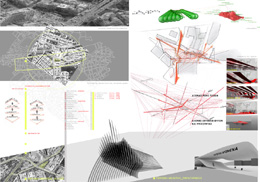STUDENTS PROJECTS
2010

02 August, 2010
Urban info units
The urban units aim to normal-distribute the flow of information in the basin of Attica.
Students: Ellinas Christos
Professor: Papaleksopoulos Dimitris
National Technical University of Athens, July 2010
The research focuses on how the stream of information concerning cultural matters is distributed in city. The urban units aim to normal-distribute the flow of information in the basin of Attica. Simultaneously, another objective of the urban unit network is to promote social awareness for individuals linking the gap between digital and natural space.


A registry of different qualities and quantities is created, including five cultural parametrs detected in and out of the limits of Athens municipality: cinemas - theaters - museums - cultural centers - musical events. The severalty of information made it imperative for both summer and winter registration. Points as "on" places are the subject of the recording. The metacenter points contribute in a diagrammatic depiction of the existing situation in the urban web. The analysis results are data that will later on be used for choro-thetisis but also will be responsible for transition of the info units in real time.


A parametric tool has being used to record the cultural parameters and to locate the stream of information with its condensing and rarefactions in the urban web and for further analysis in a selected zone. For the localization of the regions that luck information but also for the equilibrium of information two methods are adopted: "Diameter of influence - repulsion regions" and "Minus-Plus". The first method concerns the distance that can be covered by foot in a constant time interval (80m/ 1 min) The second method concerns the way that choro-thetisis of the units takes place assuming that the stream of information is positively pre-signaled and is repelled by repulsion regions (where information already exists).

In larger scale, topology -by and large cultural parameters- is registered with "tractors/ attractors" including four topology characteristics: pedestrian flow, viewports, umbra and corporeity in the region of intervention, the Hilton area. The characteristics of the region of intervention combined with the proposed synthesis principles, like the movement of pedestrian flow axis, viewports and corporeity, shape the field where information is prone to be accommodated. "Average surface" is an experimental process of searching for a surface that registers tras-topological characteristics but also sets off specific synthesis principles.


Various experimentations for the genesis of form where conducted, observing and trying to simulate the dipole of coiling (winter) and dissemination (summer). Similar principle was observed at the analysis stage, after concluding the recording of cultural parameters throughout the duration of a year. At the same time, experiments where made for the emergence of a form that rises from an inactive, at the beginning, field that belongs in the "Average surface" of the region of intervention. The field is extended up to the limits of the road network and the urban web is also taken into consideration.


The dipole of intensity and inactivity, inspired by the basic principles of the three-belted armadillo's defense system, transforms these units in a an open/ closed circuit where the latter case comes in order to accommodate the information of a major cultural event.












